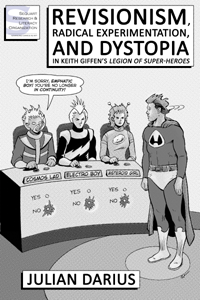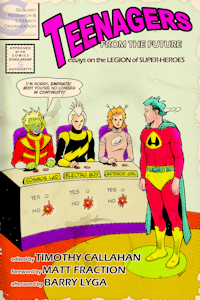We previously examined the first four issues of Giffen and DeMatteis’ seminal Justice League from 1987-1988. Today, we conclude our examination of that title’s first year, which works as its own unit.
Chronologically, the next issue was Justice League Annual #1 (1987), which features Dr. Fate a functioning part of the team for the first and only time. It tells a magic-based story involving Blue Bettle’s company, Kord Enterprises, but it doesn’t add much to the overall story. It’s also penciled by Bill Willingham, rather than Kevin Maguire. While important to include for the sake of completion, it’s not essential to the story told in first 12 issues.
In issue #5 (Sept 1987), Guy Gardner’s demand to become team leader reaches fruition, as Batman accepts his challenge – and decks him with one punch. Black Canary enters late, and her only concern isn’t that a Leaguer’s unconscious on the floor – it’s that she missed it. The League is soon drawn into Stone Ridge, Vermont, where the Gray Man is holding Dr. Fate hostage and has transformed the town’s buildings into a chaotic, organic landscape. Dr. Fate had recently been retooled as a Lord of Order, and the Gray Man is a Lord of Chaos, trying to steal mankind’s dreams. To make things even more crazy, the League finds the crazy DC character the Creeper in Stone Ridge.
The story continues in the next two issues (Oct and Nov 1987), and it’s not particularly memorable. The Creeper isn’t given much to do, and victory comes solely through Dr. Fate’s actions, separated from the League. But issue #7 wraps that plot up quickly, and it’s the rest of that double-sized issue that’s revolutionary.
Even before that, issue #7 begins with Guy Gardner waking up on the floor from where he was knocked unconscious by Batman. His power ring has apparently rolled under a computer console, and he goes looking for it, stretching to reach it – before banging his head and knocking himself unconscious again. When the League returns from Vermont, Guy Gardner’s personality has completely changed. Instead of spouting sexist proto-fascist nonsense, he peppers his dialogue with “Gosh, fellows” and “Gee whiz.” He even suggests consulting Batman.
In that issue, Giffen also begins characterizing Mister Miracle as a resident of suburbia browbeaten by his brawny wife, Big Barda. Their relationship dates to Jack Kirby’s original comics, in which these two extraterrestrials adventured on Earth. Placing these two cosmic characters into 1980s suburbia was a stroke of genius, as their struggles to succeed at American suburban life would later provide many opportunities for comedic and even satirical juxtaposition. Re-characterizing the female warrior as being equally ferocious in marriage also made sense; even as she screams at Mister Miracle in this issue, she wears bunny slippers in her kitchen, signaling just how unsuited she is to the life of a suburban housewife. But as much as this borders on cliché, her aspirations in this direction show an attempt to adopt American culture similar to many immigants. And though funny, it also comments on the collapse, in the 1980s, of 1950s expectations about gender and class.
The issue’s conflict comes as a satellite, somehow connected to Maxwell Lord, blasting a laser across the face of the planet, causing wide-scale destruction. The League takes a space shuttle into orbit, disabling the satellite in a fun sequence, during which the League wears space suits. In the process, Batman’s suit is damaged, and his survival indicates to him that this is yet another set-up, not unlike the U.N. terrorists of issue #1.
At the same time, Maxwell Lord has been using Oberon and the Martian Manhunter to push for the U.N. to sanction the League as an international peacekeeping force, with embassies around the globe. The League’s disabling of the satellite helps, as does Superman, who speaks in favor of the proposal, after talking with President Reagan. As part of the deal, the League admits Captain Atom, a former Charleton hero (like Blue Beetle) who works for the United States government, and Rocket Red #7, one of the Soviet Union’s many Rocket Reds. Captain Marvel bows out, leaving the team, and Batman resigns as team leader, preferring to avoid the spotlight and leaving Martian Manhunter in charge.
Thus, the Justice League becomes Justice League International, and the title was similarly changed with that very issue. Despite the humor of the comic, this also offered a commentary on the times. Super-heroes had long happened to occur in the United States, although DC had attempted to rectify this problem with the Rocket Reds. As nuclear tensions rose under President Reagan’s provocative anti-Soviet rhetoric, even as the Soviet Union was finally run by a reformer, Americans craved a new international era of cooperation. As silly as Giffen’s League was, it was continuing to inject real-world politics into its stories in unprecedented ways.
The next issue focuses on the League establishing its various international embassies and is notable for its lack of any super-hero fight scenes, then an extreme rarity. Of course, everything goes wrong: Martian Manhunter falls through the floor, Captain Atom fries the security system, and a brand-new jet arrives, then falls through a roof apparently not designed to support such weight. The issue first establishes Martian Manhunter’s love for Oreo cookies, which would later become a staple of his depiction in the series. It also introduces Catherine Cobert, the League’s Parisian bureau chief. Most importantly, the issue begins Blue Beetle and Booster Gold’s partnership, as the two take to the street of Paris and Booster’s confidence at picking up a girl fails him utterly. While mocking Booster’s sexism, the sequence also explores culture shock, as the pair finds themselves unable to adapt to French culture.
Issues #9-10 tied into DC’s Millennium crossover, which revealed various DC characters as sleeper agents for the Manhunters, a group of evil extraterrestrial androids that preceded the Green Lantern Corps. In issue #9 (Jan 1988), new member Rocket Red #7 revealed himself as an android Manhunter and is destroyed – but only after the other Rocket Reds aid the League and its jet is forced to land in Bialya, triggering another appearance by Colonel Harjavti (introduced in #2-3). The favorable treatment of the Soviet Rocket Reds illustrates the new international flavor of the series: Blue Beetle even says, “Whoever said ‘better dead than red’ never met this bunch!”
The issue ends with Maxwell Lord’s secretary, Ms. Wootenhoffer, also revealing herself as a Manhunter and shooting Lord. It’s clear that Lord’s plans haven’t included the events of Millennium. The excellent, dramatic sequence ends with Wootenhoffer’s death at the hands of a robotic arm, suggesting at the long-running issue of who might be the unknown mastermind behind Lord’s machinations.
Issue #10 (Feb 1988) follows several Leaguers, along with other characters, on their assault on the Manhunter homeworld, where they battle scores of android Manhunters, culminating in the entire planet’s destruction. It’s an entertaining issue, though it has a lot more to do with the plot of Millennium than Justice League International.
By the next issue (Mar 1988), Millennium had concluded and the Soviet Union had sent Rocket Red #4 to replace the team’s Manhunter agent. Giffen thus begins to conclude the Maxwell Lord storyline that has defined the title’s first year. He does this by having Lord reach out to the League, raving in fear about his overlord – though this seems rather staged. Amusingly, Lord complains about needing power, “not a bunch of weak-kneedsecond-stringers!” – causing Captain Atom and Martian Manhunter to debate whom Lord is referencing (Blue Beetle, they conclude). Lord’s complaints about his computer being co-opted sound like the old League villain the Construct, and the team does encounter this villain as an enormous android. But they defeat him too easily, and Batman suspects there’s more to learn. As the Construct returns to his base, collapsing through it, the League enters to find Metron – a cosmic observer created by Jack Kirby as part of his larger Fourth World project, which also included Mister Miracle and Big Barda.
Issue #12 (Apr 1988) concludes the Maxwell Lord storyline. It begins by revealing that Metron isn’t the culprit – which wouldn’t make sense, given his neutral, scientific past. He’s only present because of a signal triggered by a problem with a computer station he left there. His computer itself is the real villain, having achieved sentience in Metron’s absence.
And thus we learn the secret origin of Maxwell Lord, an amoral businessman who attempted to eliminate a rival with a spelunking accident. At the bottom of the cave, he found Metron’s sentient computer, which showed him a new outlook on life. Lord suddenly became a huge success in business and used his spare time to construct a new, self-sufficient frame for the computer that had helped him. But the computer, seeing the world teetering on nuclear annihilation, made a logical determination: “We must save Earth’s population from themselves.” At this point, the issue recounts the series thus far from this new perspective, as Lord gives Dr. Light a signal device and funds the terrorists who take over the U.N. Besides recruiting Booster Gold, Lord orchestrated the Royal Flush Gang’s attack, and the computer constructed the villain’s most powerful member. To seal the deal on the team’s U.N. endorsement, the computer activated its laser satellite.
With everything explained, Lord decides to destroy the computer – and does so, although this means the computer’s repairs of his own body, following his shooting (in issue #9), dramatically come undone. The issue ends as Mister Miracle visits an unconscious Lord in the hospital and, after Oberon voices support for Lord, leaves a League signal device in Lord’s hands, representing his forgiveness and future involvement with the League.
Once again, the League has triumphed due to no actions of its own, subverting super-hero conventions. Lord’s story proves far more interesting than any direct conflict would have been, tying not only into real-world nuclear tensions but the world of 1980s cutthroat business, then making headlines for corporate takeovers that raided pension funds. Super-teams often come into existence passively, only in response to a super-villain threat; this one, however, was further mentored by that villain and granted unprecedented power as an international agency.
While resolving the plot of Maxwell Lord’s manipulations, this revelation of the League’s origins implicitly makes the League responsible for saving humanity from itself – ironic, given the title’s humor. But then again, Giffen’s League owed its success to this smart blend of humor and melodramatic, super-villain threats – a blend that often reflected real-world tensions.
While issue #12 concludes the first leg of Giffen’s League, it also hints at plots to come. Two pages show the disbanding of the super-hero team the Global Guardians. Two female members, Green Flame and Ice Maiden, now worry about how they’ll continue shopping. Their plan is to simply walk into a Justice League embassy and demand to join, figuring the team could use new members with its expanded mission. It’s a typical motivation for Giffen’s group, and both women, renamed simply Fire and Ice, would become staples of the League for years to come.
































































